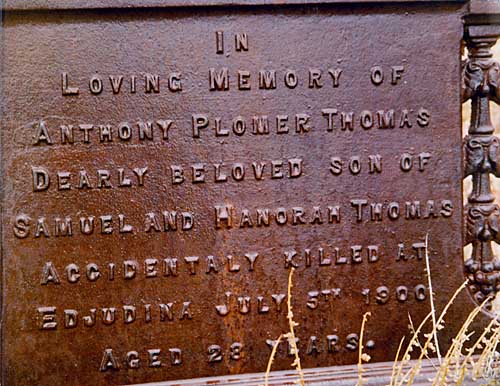Region: Goldfields-Esperance
Coordinates: -29.791944, 122.493889
Directions: Located in the Shire of Menzies, 230 kms NE of Kalgoorlie and 130 kms S of Laverton
Reserve Number 8679
Number of Graves: 7
First Burial: On 18 April 1900, William Edward TREE, an inspector of public batteries, aged 29 years, died of syncope (sudden drop in blood pressure leading to lack of blood supply to the brain) caused by over-exertion .
Last Burial: On 26 May 1929, Auguste Carles (Charlie) WAACK, a prospector and sandalwood cutter, aged 71 years, died of natural causes. (Buried two miles from the townsite)
History
Name
The name Edjudina is probably of indigenous origin, but its meaning has been lost. An alternative explanation may be connected to the game of two-up. See the photo section below.
Discovery
Gold was discovered at Edjudina in 1893 by Dick Peaks and Bill Vickers. During its very early years the locality was known as Peak's Find. The gold proved to be rich at the surface but poor at depth.
Early History
Edjudina began as a pastoral lease established by Walt Newland in 1892. It was one of the first pastoral leases in the Goldfields and ran sheep. Newland with several others later owned the lease of Neta Gold Mine at the northern end of the field. It appears that a townsite was never gazetted, the nearest town being Yarri, only a couple of miles north.
From 1895, several large companies were floated in England to acquire the leases. Large scale development took place, many men were employed and shareholder cash splashed around erecting plants before development work had confirmed the amount of gold. Within two years, all but one had collapsed, the remaining company exiting in 1900. While rich surface gold was found, the values at depth were poor.
A small town developed but was little more than a couple of stores and pub. Gable, Gardener and Jones were early storekeepers. They also built at their own cost, a 100-gallon tank for a condenser between Kurnalpi and Edjudina, and it was only through this that prospectors were able to reach the field through the waterless desert. The Clifford brothers were also pioneer storekeepers, while E.J. Monaghan built and ran the pub.
Four major underground mines operated between 1898 and 1939. Several private batteries were erected on the goldfield from the 1890s to the 1930s. The gold boom of the 1930s saw a repeat of the earlier frenzy to invest and develop mines with the same lack of success.
Edjudina Consolidated Gold Mines Ltd commenced operations in 1937 but closed down shortly after, due to declining market conditions for gold.
Statistics
|
AGES AT DEATH |
|||||
|
0 – 1 |
1 |
20 – 29 |
2 |
60 – 69 |
0 |
|
2 – 5 |
0 |
30 – 39 |
2 |
70 – 79 |
1 |
|
6 – 9 |
0 |
40 – 49 |
1 |
80 + |
0 |
|
10 – 19 |
0 |
50 – 59 |
0 |
Unknown |
0 |
|
OCCUPATIONS |
|||||
|
Child |
1 |
Miner |
2 |
Publican |
1 |
|
Inspector of public batteries |
1 |
Prospector |
1 |
Woodcutter |
1 |
|
CAUSE OF DEATH |
|||||
|
Cancer |
1 |
Mine Accident |
2 |
Suicide by shooting |
1 |
|
Heart failure |
1 |
Natural Causes |
1 |
Syncope |
1 |
Headstone of Anthony Thomas
 Plaque on grave of Anthony Thomas
Plaque on grave of Anthony Thomas

Neta Gold Mine, Edjudina 1913 (Photo from State Library WA)

Edjudina Water Tank c19209 (Photo from State Library WA)

Old map of Edjudina

Edjudina map (from State Records Office WA)
The Edjudina Goldfield contains the longest line of auriferous reefs in Australia at approximately 20 kilometres long. There are four to five parallel reefs for the entire line of lode, with historic workings seen virtually its entire length.
The region is known as an Australite hotspot. These are small tektites commonly found around the salt lake margins. They are shaped like discs or bowls and are black or very dark in colour. It is believed they were formed during a large asteroid or comet impact on Earth.
The National History Museum in London also contains the Edjudina Meteorite, 4.48 kg olivine-bronzite, discovered in the area in the late 1960's. The meteorite was found by I.R. Williams from the Geological Survey of Western Australia while mapping the area.
